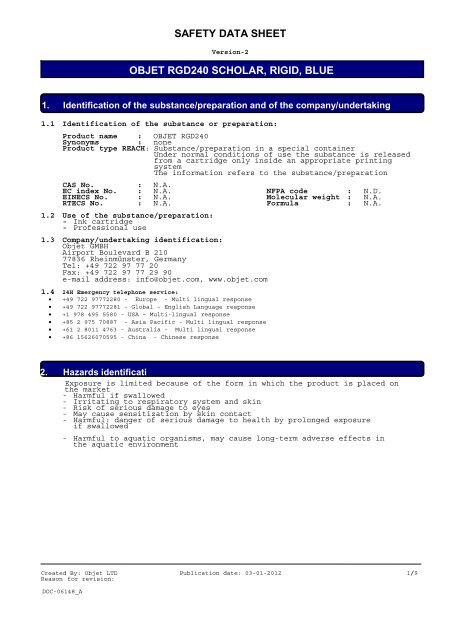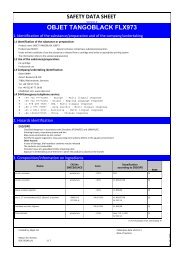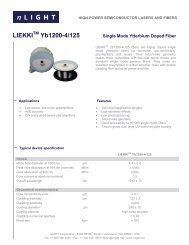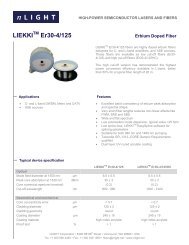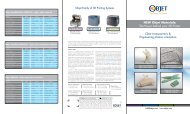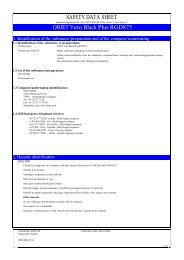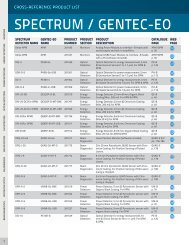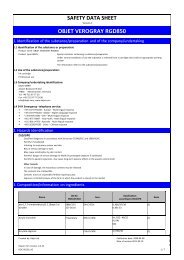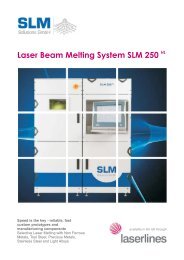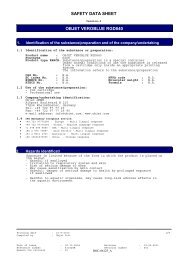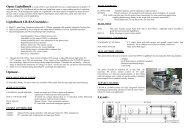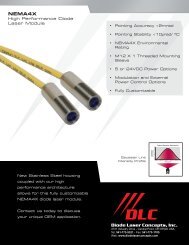Objet RGD240 Scholar Rigid Blue_Version_2_EU - Laser Lines Ltd.
Objet RGD240 Scholar Rigid Blue_Version_2_EU - Laser Lines Ltd.
Objet RGD240 Scholar Rigid Blue_Version_2_EU - Laser Lines Ltd.
Create successful ePaper yourself
Turn your PDF publications into a flip-book with our unique Google optimized e-Paper software.
SAFETY DATA SHEET<strong>Version</strong>-2OBJET <strong>RGD240</strong> SCHOLAR, RIGID, BLUE1. Identification of the substance/preparation and of the company/undertaking1.1 Identification of the substance or preparation:Product name : OBJET <strong>RGD240</strong>Synonyms : noneProduct type REACH: Substance/preparation in a special containerUnder normal conditions of use the substance is releasedfrom a cartridge only inside an appropriate printingsystemThe information refers to the substance/preparationCAS No. N.A.EC index No. N.A. NFPA code N.D.EINECS No. : N.A. Molecular weight : N.A.RTECS No. : N.A. Formula : N.A.1.2 Use of the substance/preparation:- Ink cartridge- Professional use1.3 Company/undertaking identification:<strong>Objet</strong> GMBHAirport Boulevard B 21077836 Rheinmünster, GermanyTel: +49 722 97 77 20Fax: +49 722 97 77 29 90e-mail address: info@objet.com, www.objet.com1.4 24H Emergency telephone service:• +49 722 97772280 - Europe - Multi lingual response• +49 722 97772281 - Global – English Language response• +1 978 495 5580 - USA – Multi-lingual response• +85 2 975 70887 - Asia Pacific - Multi lingual response• +61 2 8011 4763 - Australia - Multi lingual response• +86 15626070595 - China - Chinese response22. Hazards identificatiExposure is limited because of the form in which the product is placed onthe market- Harmful if swallowed- Irritating to respiratory system and skin- Risk of serious damage to eyes- May cause sensitization by skin contact- Harmful: danger of serious damage to health by prolonged exposureif swallowed- Harmful to aquatic organisms, may cause long-term adverse effects inthe aquatic environmentCreated By: <strong>Objet</strong> LTD Publication date: 03-01-2012 1/9Reason for revision:DOC-06148_A
OBJET <strong>RGD240</strong> SCHOLAR, RIGID, BLUE3. Composition/information on ingredientsHazardous ingredientsCAS No.EINECS/ELINCS No.Conc. (%)Hazards(R-phrases)HazardsymbolAcrylic monomer Proprietary
OBJET <strong>RGD240</strong> SCHOLAR, RIGID, BLUE6. Accidental release measures6.1 Personal precautions:See heading 8.26.2 Environmental precautions:- Prevent soil and water pollution- Prevent spreading in sewers- Contain leaking substance- Dam up the liquid spill- See heading 136.3 Methods for cleaning up:- Take up liquid spill into absorbent material, e.g.: sand- Scoop absorbed substance into closing containers- Carefully collect the spill/leftovers- Clean contaminated surfaces with an excess of water- Wash clothing and equipment after handling7. Handling and storage7.1 Handling:In case of damage, the hazardous contents may be releasedAccidental release of the contents:- Observe very strict hygiene - avoid contact- Do not discharge the waste into the drain- Remove contaminated clothing immediately7.2 Storage:- Keep container tightly closed- Store at room temperature- Keep out of direct sunlight- Store in a dry area- Keep away from: heat sourcesStorage temperature : N.D. °CShipment temperature - up to 5 weeks: -20 to 50°CQuantity limits : N.D. kgStorage life : N.D. daysMaterials for packaging :- suitable : no data available- to avoid : no data available7.3 Specific use(s):- See information supplied by the manufacturer for the identified use(s)DOC-06148_A : 3/9
OBJET <strong>RGD240</strong> SCHOLAR, RIGID, BLUE8. Exposure controls/Personal protection8.1 Exposure limit values:8.1.1 Occupational exposure:TLV-TWATLV-STEL: not listed: not listedTLV-Ceiling : not listedWEL-LTELWEL-STELTRGS 900MAK: not listed: not listed: not listed: not listedGWBNL-TGG 8 h : not listedGWKNL-TGG 15 min. : not listedCeiling: not listedVME-8 hVLE-15 min.GWBB-8 hGWK-15 min.Momentary valueECEC-STEL: not listed: not listed: not listed: not listed: not listed: not listed: not listed8.1.2 Sampling methods:- NO DATA AVAILABLE8.2 Exposure controls:8.2.1 Occupational exposure controls:Accidental release of the contents:- Work under local exhaust/ventilationPersonal protective equipment:a) Respiratory protection:- Not required for normal conditions of use- Insufficient ventilation: wear respiratory protectionb) Hand protection:- Accidental release of the contents: GlovesSuitable materials:No data available- Breakthrough time: N.D.c) Eye protection:- Accidental release of the contents: Face shieldd) Skin protection:- Accidental release of the contents: Protective clothingSuitable materials:No data available8.2.2 Environmental exposure controls: see headings 6.2, 6.3 and 13DOC-06148_A : 4/9
OBJET <strong>RGD240</strong> SCHOLAR, RIGID, BLUE9. Physical and chemical properties9.1 General information:Appearance (at 20°C)OdourColour: Ink cartridge: The contents: mild odour: The contents: light blue9.2 Important health, safety and environmental information:pH value (at %) : N.D.Boiling point/boiling range : N.D. °CFlash point/flammability : > 100 °CExplosion limits (explosive properties) : N.D. vol%Oxidising properties: N.D.Vapour pressure (at 20°C) : N.D. hPaVapour pressure (at 50°C) : N.D. hPaRelative density (at 20°C): N.D.Water solubility: The contents are: insolubleSoluble in: N.D.Relative vapour density: N.D.Viscosity (at °C) : N.D. Pa.sPartition coefficient n-octanol/water : N.D.Evaporation rateratio to butyl acetate: N.D.ratio to ether: N.D.9.3 Other information:Melting point/melting range : N.D. °CAuto-ignition temperature : N.D. °CSaturation concentration : N.D. g/m 3Specific conductivity : N.D. pS/m10. Stability and reactivity10.1 Conditions to avoid:- Unstable on exposure to heat- Unstable on exposure to light10.2 Materials to avoid:- Keep away from: heat sources10.3 Hazardous decomposition products:- After destruction: polymerizes on exposure to light- On burning: release of toxic and corrosive gases/vapours (nitrous vapours,carbon monoxide - carbon dioxide) and formation of small quantities ofphosphorus oxides11. Toxicological information11.1 Acute toxicity:Acrylic monomerLD50 oral ratLD50 dermal rat: 588: > 2000mg/kgmg/kgexo-1,7,7-trimethylbicyclo[2.2.1]hept-2-yl acrylateLD50 oral rat : 4890 mg/kgLD50 dermal rabbit : > 5000 mg/kgDOC-06148_A : 5/9
11.2 Chronic toxicity:EC carc. cat.: not listedEC muta. cat.: not listedEC repr. cat.: not listedCarcinogenicity (TLV) : not listedCarcinogenicity (MAC) : not listedCarcinogenicity (VME) : not listedCarcinogenicity (GWBB) : not listedCarcinogenicity (MAK) : not listedMutagenicity (MAK) : not listedTeratogenicity (MAK) : not listedIARC classification : not listedOBJET <strong>RGD240</strong> SCHOLAR, RIGID, BLUE11.3 Routes of exposure:In normal conditions of use, the hazardous contents cannot be released11.4 Acute effects/symptoms:- AFTER INHALATION- Irritation of the respiratory tract- Irritation of the nasal mucous membranes- AFTER SKIN CONTACT- Tingling/irritation of the skin- AFTER EYE CONTACT- Irritation of the eye tissue- Inflammation/damage of the eye tissue11.5 Chronic effects:The following symptoms may appear when the components are released:- May cause sensitization by skin contact- Prolonged exposure: danger of damage to health if swallowed- ON CONTINUOUS/REPEATED EXPOSURE/CONTACT:- Skin rash/inflammation12. Ecological information12.1 Ecotoxicity:- No data available- Effect on waste water purification : no data available12.2 Mobility:- Volatile organic compounds (VOC): N.D.%- Insoluble in waterFor other physicochemical properties see heading 912.3 Persistence and degradability:- biodegradation BOD 5 : N.D. % ThOD- water : N.D.- soil : T ½: N.D. days12.4 Bioaccumulative potential:- log P ow : N.D.- BCF : N.D.12.5 Results of PBT assessment:- Not applicable, based on available data.DOC-06148_A : 6/9
12.6 Other adverse effects:OBJET <strong>RGD240</strong> SCHOLAR, RIGID, BLUE- WGK : 3 (Classification water polluting based on the componentsin compliance with Verwaltungsvorschriftwassergefährdender Stoffe (VwVwS) of 27 July 2005 (Anhang4))- Effect on the ozone layer : Not dangerous for the ozone layer(1999/45/EC)- Greenhouse effect : no data available13. Disposal considerations13.1 Provisions relating to waste:- Waste material code (91/689/EEC, Council Decision 2001/118/EC, O.J. L47 of16/2/2001): 08 03 12* (waste ink containing dangerous substances)- LWCA (the Netherlands): KGA category 03- Hazardous waste (91/689/EEC)- Remove waste in accordance with local and/or national regulations13.2 Disposal methods:- Refer to manufacturer/supplier for information on recovery/recycling- Do not landfill- Do not discharge into drains or the environment13.3 Packaging/Container:- No available data14. Transport information14.1 Classification of the substance in compliance with UN RecommendationsUN number :CLASS: Not subjectSUB RISKS :PACKING GROUP :14.2 ADR (transport by road)CLASS: Not subjectPACKING GROUP :CLASSIFICATION CODE :DANGER LABEL TANKS :DANGER LABEL PACKAGES :PROPER SHIPPING NAME :14.3 RID (transport by rail)CLASS: Not subjectPACKING GROUP :CLASSIFICATION CODE :DANGER LABEL TANKS :DANGER LABEL PACKAGES :PROPER SHIPPING NAME :14.4 ADNR (transport by inland waterways)CLASS: Not subjectPACKING GROUP :CLASSIFICATION CODE :DANGER LABEL TANKS :DANGER LABEL PACKAGES :14.5 IMDG (maritime transport)CLASS: Not subjectSUB RISKS :PACKING GROUP :MFAG :EMS :MARINE POLLUTANT :14.6 ICAO (air transport)CLASS: Not subjectSUB RISKS :PACKING GROUP :PACKING INSTRUCTIONS PASSENGER AIRCRAFT :PACKING INSTRUCTIONS CARGO AIRCRAFT :14.7 Special precautions : Not restricted for any mode ofinternational transportDOC-06148_A : 7/9
OBJET <strong>RGD240</strong> SCHOLAR, RIGID, BLUE15. Regulatory information15.1 <strong>EU</strong> legislation:Labelling according to Regulation (EC) No 1907/2006Exposure is limited because of the form in which the product is placed onthe marketHarmfulcontains:epoxy acrylate; acrylic monomer; methacrylic monomerR22 : Harmful if swallowedR37/38 : Irritating to respiratory system and skinR41 : Risk of serious damage to eyesR43 : May cause sensitisation by skin contactR48/22 : Harmful: danger of serious damage to health byprolonged exposure if swallowedR52/53 : Harmful to aquatic organisms, may cause long-termadverse effects in the aquatic environmentS24 : Avoid contact with skinS26 : In case of contact with eyes, rinse immediately withplenty of water and seek medical adviceS35 : This material and its container must be disposed of ina safe wayS37/39 : Wear suitable gloves and eye/face protectionS61 : Avoid release to the environment. Refer to specialinstructions/safety data sheets.15.2 National provisions:The Netherlands:Waterbezwaarlijkheid: 4Germany:WGK : 3 (Classification water polluting based on the componentsin compliance with Verwaltungsvorschriftwassergefährdender Stoffe (VwVwS) of 27 July 20054))16. Other informationThe information provided on this SDS is correct to the best of our knowledge, information and beliefat the date of its publication. The information given is designed only as a guidance for safehandling, use, processing, storage, transportation, disposal and release and is not to be consideredas a warranty or quality specification. The information relates only to the specificmaterial designated and may not be valid for such material used in combination with any othermaterial or in any process, unless specified in the text.N.A. = NOT APPLICABLEN.D. = NOT DETERMINED(*) = INTERNAL CLASSIFICATION (NFPA)PBT-substances = persistent, bioaccumulative and toxic substancesDOC-06148_A : 8/9
OBJET <strong>RGD240</strong> SCHOLAR, RIGID, BLUEExposure limits:TLV : Threshold Limit Value - ACGIH USAWEL : Workplace Exposure Limits - United KingdomTRGS 900 : Technische Regel für Gefahrstoffe 900 (Arbeitsplatzgrenzwerte) - GermanyMAK : Maximale Arbeitsplatzkonzentrationen - GermanyGWBNL : Grenswaarde voor blootstelling - The NetherlandsGWKNL : Grenswaarde korte duur - The NetherlandsVME : Valeurs limites de Moyenne d’Exposition - FranceVLE : Valeurs limites d’Exposition à court terme - FranceGWBB : Grenswaarde beroepsmatige blootstelling - BelgiumGWK : Grenswaarde kortstondige blootstelling - BelgiumEC : Indicative occupational exposure limit valuesChronic toxicity:K : List of the carcinogenic substances and processes - The NetherlandsFull text of any R phrases referred to under headings 2 and 3:R20/22 : Harmful by inhalation and if swallowedR22: Harmful if swallowedR36/37/38 : Irritating to eyes, respiratory system and skinR36/38 : Irritating to eyes and skinR41: Risk of serious damage to eyesR43: May cause sensitisation by skin contactR48/22 : Harmful: danger of serious damage to health by prolonged exposure if swallowedR51/53 : Toxic to aquatic organisms, may cause long-term adverse effects in the aquaticenvironmentDOC-06148_A : 9/9


